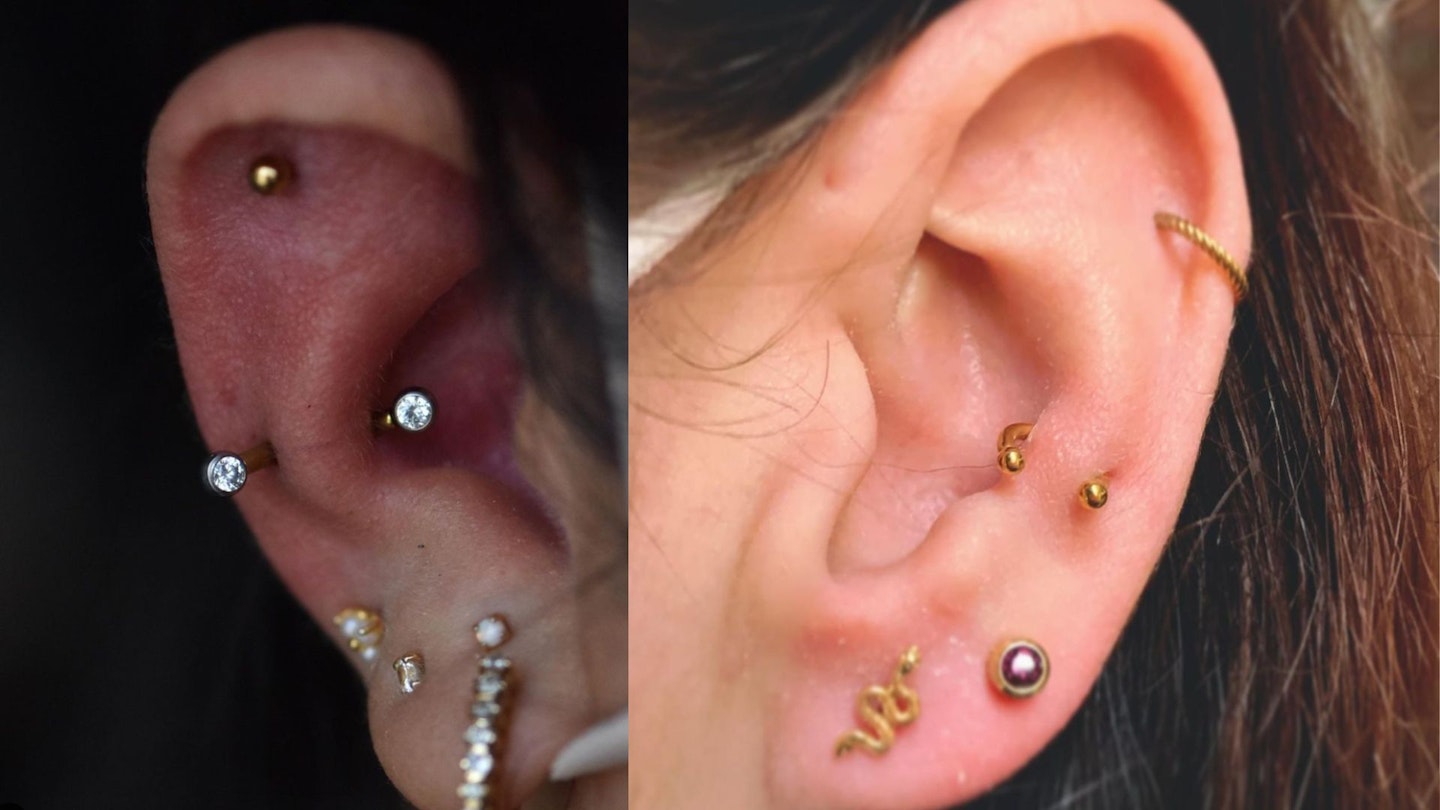When it comes to ear piercings, the options truly feel limitless. There are conch piercings, daith piercings, tragus piercings and everything in between, each enabling you to create your perfect curated selection of stackable earrings. And if you're looking for the next one to add to the mix, let us introduce you to the snug piercing. Like the name suggests, it's a fine little piercing that sits neatly along the outer ear but when you catch sight of its shimmer, its subtle dazzling impact is enough to make you feel smug. Want to know more? We've got you covered. We spoke to Raph Head Piercer at Pierce Me London Studioto bring you up to speed with everything you need to know.
Snug Piercing At A Glance:
Where is it?: Between the rim of your ear and the inner cartilage
Price: £40-£80
Pain Level: 8-9/10
Healing Time: 6-12 months
Best Jewellery: Titanium (ASTM F136 grade), Implant-grade stainless steel and Solid Gold (14ct and up)
Aftercare: Saline solution
What Is A Snug Piercing?
One of the newer piercing types, it's a horizontal double-ended piercing located at the top of the anti-tragus (the pointy, triangular piece of cartilage at the top of the lobe) and is inserted through the anti-helix which can be found between the rim of your ear and the inner cartilage. It's positioned midway up the ear, in between the ridges of your ear rim and is considered a more alternative style of ear piercing thanks to the thick piece of cartilage the piercing passes through, ouch (more on that later)!
What Is The Best Jewellery For A Snug Piercing?
For jewellery, it's essential to use high-quality pieces made from titanium, gold, or implant-grade stainless steel. Raph explains that it's best to wear a curved barbell, ‘longer initially, and to get it shortened by a professional post-healing period. Implant-grade titanium, 14Kt gold, or 18Kt gold are the best materials. In terms of thickness, the snug piercing is usually pierced at 1.6 mm initially.’
How Is A Snug Piercing Done?
Given the tight location of a snug piercing, perfect marking may take more time than a regular ear piercing. The area is cleaned first, then a professional piercer marks the ear with a skin-safe pen to ensure correct placement. Raph explains, ‘A snug piercing is most often pierced with a receiving tube, but it can also be performed using pliers or even with a freehand technique,’ followed by the insertion of jewellery.
Pain
This piercing isn't for the faint-hearted due to the thickness of the cartilage the needle must pass through, resulting in a higher level of pain compared to other ear piercings. However, those with a higher pain threshold might find this piercing manageable. Raph, Head Piercer at Pierce Me London, says, ‘The soreness can be fairly intense during the initial piercing, but the piercing itself is very quick, so the intensity does not last longer than a deep breath! The body gradually numbs the area once the piercing has been performed. To avoid extra soreness during the healing period, it is extremely important to be gentle with the area.’
What Is The Aftercare Like?
Healing can be long and fairly tender due to the size of the cartilage. It is important to avoid headphones, mobile phones, and sleeping on the ear during the healing process, or it might not heal well, remaining painful and swollen for longer. Experts note that the healing period usually lasts 6 to 12 months. Raph recommends aftercare, advising, ‘use a sterile saline spray twice daily or perform long, warm, frequent saline soaks for the first 4 months. The piercing should always air dry naturally or be dried gently with disposable paper.’ He also advises avoiding ‘baths, saunas, swimming, and tanning for the first 2 weeks of the healing period. After the first 2 weeks, if engaging in these activities, the area should be rinsed well afterwards.’ Touching and fiddling with the piercing is strongly discouraged, as it increases the chance of infection and irritation. The best advice is to leave the piercing alone while it heals. Finally, Raph warns that ‘cosmetic creams and sprays should not come into contact with the piercing until it is fully healed.’
What Are The Risks?
Raph notes, ‘If the piercing is performed by an experienced professional body piercer, the risks are minimal. Yet it is a piercing that may migrate or grow out if it is improperly placed, and/or if the jewellery is not downsized after the healing period.’ He emphasises the importance of returning to the body piercer after the healing period to get shorter jewellery fitted.
Raph also explains, ‘most people do not have the correct anatomy to get a snug piercing: there should be a tall enough ridge of tissue for the piercing to sit properly and for it to be pierced at the right depth. If a person does not have an anatomy suitable for this piercing, a 'faux snug' could be a nice alternative. A faux snug is two piercings framing the ridge (one conch and one helix piercing), and they can create the same look without passing through the thick ridge of the front of the ear’s cartilage.’
